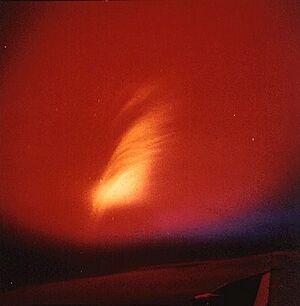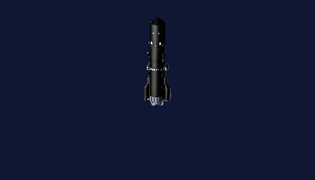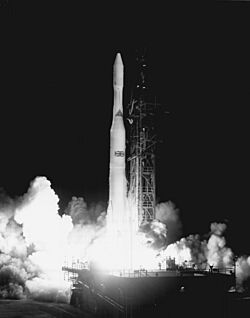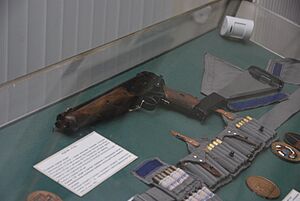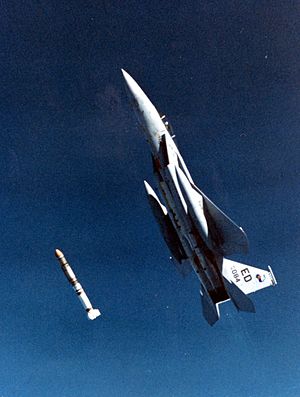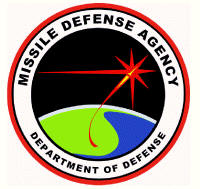Militarisation of space facts for kids
The militarisation of space means putting military tools and weapons into outer space. When people first started exploring space in the mid-1900s, a big reason was for military purposes. Countries like the United States and the Soviet Union wanted to show off their advanced rocket technology. This technology could also be used for military goals.
Today, space is a place where military spacecraft operate. These include satellites that take pictures or help with communication. Some long-range rockets also travel through space. As of 2018, the only known weapons actually placed in space were on the Almaz space station and special pistols like the TP-82 Cosmonaut survival pistol. These pistols were for cosmonauts to use after landing, before they were rescued.

Contents
How Did Space Become Important for Militaries?
The Cold War Era
The Cold War was a time when the Soviet Union and the United States were rivals. Both countries spent a lot of money on new military technologies. The idea of putting things into space really pushed space research forward. This led to the exciting Space Race. In 1957, the Soviet Union launched Sputnik 1, the first artificial satellite to orbit Earth.
By the late 1960s, both nations were regularly sending satellites into space. Reconnaissance satellites, also known as spy satellites, took detailed pictures of military sites belonging to their rivals. These satellites became very good at their job. This made both sides worried about what the other could see. So, they started working on anti-satellite weapons. These weapons were designed to disable or destroy the other side's satellites. They looked into things like powerful energy beams and satellites that could crash into others.
Spy satellites were also used to check if countries were following agreements to reduce their military equipment. These agreements are called arms control treaties. Satellites helped make sure everyone was playing fair.
Both superpowers also developed ballistic missiles. These were rockets that could carry very powerful devices over long distances. As rocket technology improved, they created intercontinental ballistic missiles (ICBMs). These rockets could reach almost any target on Earth in just minutes. To travel such long distances, these missiles usually go into sub-orbital spaceflight, which means they briefly enter space.
United States Efforts
The United States worked on several programs to defend against incoming long-range missiles. One early idea involved firing special missiles high into the sky. These would cause powerful explosions to stop incoming rockets. This idea was later changed as technology improved.
In the late 1950s, the United States Air Force even thought about exploding a special bomb on the Moon. This was to show how powerful the U.S. was to the Soviet Union and the rest of the world. They also studied plans for a military base on the Moon.
Later, the U.S. developed anti-ballistic missiles (ABMs). These were designed to shoot down incoming long-range missiles. One program, the Safeguard Program, was set up in the 1970s. It used ABMs that needed very powerful devices to destroy incoming missiles. Future ABMs are designed to be more accurate. They will use direct hits or regular explosives to knock down incoming devices.
In 1983, U.S. President Ronald Reagan suggested the Strategic Defense Initiative (SDI). This was a plan for a space-based system to protect the United States from attacks by long-range missiles carrying powerful devices. Some people called it "Star Wars" after the popular movies. Critics said it was too expensive and might not work. However, supporters believed it would push the Soviet Union to spend too much money trying to keep up. This would help end the Cold War.
The United States Space Command (USSPACECOM) was created in 1985. Its job was to help the U.S. military use outer space more effectively. Space operations managed by USSPACECOM were very helpful during the 1991 Gulf War. The U.S. military has used satellites for communication, intelligence, navigation, and weather information in many conflicts since the 1990s. These space systems are now essential for providing important information to soldiers.
In 2002, USSPACECOM merged with another command, USSTRATCOM. Then, on December 10, 2019, the United States Space Force was formed. It is the world's only independent space force, with thousands of military personnel and many spacecraft.
High-Altitude Tests
In 1958, the United States carried out a series of special high-altitude tests called Operation Hardtack I. These included exploding powerful devices at very high altitudes. One test, YUCCA, was done using a balloon. Later tests, ORANGE and TEAK, used rockets.
Another important test was Starfish Prime in 1962. A very powerful device was exploded 400 kilometers (250 miles) above the Pacific Ocean. This test showed a strong Electromagnetic Pulse (EMP) effect. This pulse caused electronics to fail as far as 1400 kilometers (800 miles) away in Hawaii. About 300 streetlights in Hawaii immediately stopped working.
Soviet Union and Russia's Efforts
The Soviet Union also worked on new ways to gain an advantage in space. Two of their notable projects were the R-36ORB Fractional Orbital Bombardment System (FOBS) and the Polyus orbital weapons system.
The R-36ORB was a Soviet long-range missile from the 1960s. Once launched, it would go into a low Earth orbit. Then, it could drop down to attack targets from unexpected directions, like over the South Pole. This would make it harder for early warning systems to detect. This missile system was later removed to follow the SALT II treaty.
The SALT II treaty (1979) made it illegal to develop or use FOBS systems. It stated that countries should not put powerful devices or any other weapons that cause widespread damage into Earth orbit.
In 1987, the Energia rocket flew for the first time. It carried a test version of the Polyus orbital weapons platform. Some reports say the final version could have been armed with special space mines and defensive cannons. The Polyus platform was designed to protect itself from anti-satellite weapons. It also had a laser to confuse approaching weapons. The attempt to put this satellite into orbit failed.
The Russian Space Forces were first formed in 1992. They were an independent space force for some years. Now, they are part of the Russian Aerospace Forces.
Soviet High-Altitude Tests
The Soviet Union also conducted its own high-altitude tests. These were done to study and develop the effects of High-Altitude Electromagnetic Pulse (HEMP). In 1962, a powerful device was exploded at an altitude of 290 kilometers. The HEMP from this test damaged a 1000-kilometer long power line in Kazakhstan. All telephone lines within 500 kilometers were also damaged.
Space in the Modern World
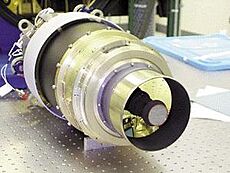
After the Cold War ended, space research focused more on peaceful uses. However, space still plays a big role in military activities. Countries like China, Japan, India, and the European Union are developing their own space programs.
Modern military uses of space often involve three main areas. (It's important to remember that much of this information is kept secret by powerful countries.)
Military Satellites
The first area is the continued development of "spy" or reconnaissance satellites. These satellites have become much more advanced since the Cold War. They perform many tasks, like taking high-resolution photos and listening in on communications. These jobs are done regularly, both during peacetime and during conflicts.
Satellites are also used by countries with powerful devices. They provide early warnings of missile launches. They can also find where powerful explosions happened. And they can detect secret preparations for tests of these devices. For example, in 1998, satellites detected tests by India and Pakistan. During the Desert Storm conflict, America used early-warning satellites to tell Israel about incoming Iraqi missiles.
Here are some examples of military satellites:
- United States: Lacrosse/Onyx, Misty, Samos, Quasar, Vela
- Soviet Union: Cosmos, Almaz (crewed), Yantar, Zenit
- United Kingdom: Skynet
- France: Helios 2A
- Germany: SAR-Lupe
- Japan: Information Gathering Satellites
- China: Fanhui Shi Weixing
- India: RISAT-1, RISAT-2
- Israel: Ofeq series
- Spain: Paz
- Turkey: Göktürk-1, Göktürk-2
Global Positioning System (GPS)
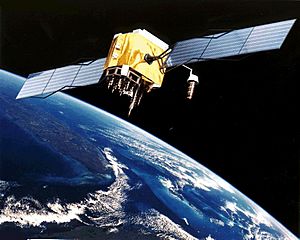
The second important use of space for military purposes is the Global Positioning System (GPS). This system helps you find your exact location and get very accurate time almost anywhere on Earth. It uses at least 24 satellites orbiting Earth. The GPS system was created and is controlled by the United States Department of Defense. Anyone can use it for free.
GPS is very important for military forces. It helps them know where their troops are and control them better. It also helps guide smart bombs, cruise missiles, and other weapons to their targets very accurately. During wartime, it can also be used to block or confuse civilian navigation signals. The satellites also have detectors for powerful explosions.
Other countries have their own navigation systems. Russia has GLONASS, and China has its "Beidou" system. Europe is also planning its own system called Galileo.
Military Communication Systems
The third way space is used by militaries is through advanced communication systems. Modern military strategies rely on very fast communication. This allows all soldiers and military branches to see what's happening on the battlefield in real-time. This improves everyone's understanding of the situation.
For example, a soldier in a battle zone can quickly get satellite pictures of enemy positions. They can then send the location to a bomber flying overhead. Meanwhile, a commander far away can watch everything unfold on a screen. This high-speed communication is made possible by a special internet created just for the military. Communication satellites connect this system, creating a network of information over the area of operations. The United States Department of Defense is working to connect all military units into one big computer network. This will help them share information and work more efficiently.
Military Spaceplanes
A spaceplane is an aircraft that can fly both in Earth's atmosphere and in outer space. It was once thought that the U.S. Space Shuttle program might have military goals, like being able to quickly drop bombs. However, studies showing this possibility came out after the Soviet Union had already started its own spaceplane program, the Buran program.
The NASA uncrewed X-37 spaceplane project was moved to the U.S. Department of Defense in 2004. Its exact military mission is not clear. People guess it might be testing new spy sensors and how they handle space radiation. The Pentagon has said the X-37 is not used for developing space-based weapons. The X-37 is like a space version of an Unmanned aerial vehicle, which is a drone that flies in the air.
Weapons in Space
Space weapons are tools used in space warfare. This includes weapons that can attack systems in orbit, hit targets on Earth from space, or disable missiles traveling through space. During the Cold War, powerful countries developed many such weapons. Some are still being developed today. Space weapons are also a common theme in science fiction movies and video games.
Special Weapons in Space
The Soviet space station Salyut 3 had a 23mm cannon. This cannon was successfully tested by firing at target satellites from different distances.
As of 2008, Russian cosmonauts often carried the TP-82 Cosmonaut survival pistol on their Soyuz spacecraft. This pistol is part of an emergency kit. It is meant to protect cosmonauts from wild animals if they land in a remote wilderness area. This special gun can fire bullets, shotgun shells, or flares.
High-Altitude Electromagnetic Pulses (HEMP)
A high-altitude electromagnetic pulse (HEMP) is a powerful burst of energy. It happens when a powerful device is exploded high in the atmosphere. The United States' Starfish Prime test and the Soviet Union's Nuclear Test 184 showed this effect. These explosions don't cause physical damage or harmful effects like those on the ground. However, HEMPs can have far-reaching effects on unprotected electronics.
The 1962 Starfish Prime test created an HEMP that caused electronics to fail 1400 kilometers (800 miles) away in Hawaii. About 300 streetlights immediately failed. Soviet tests with HEMPs over land caused a 1000-kilometer power line to shut down. All telephone lines within 500 kilometers were also damaged.
HEMPs create large, banana-shaped areas of effect. This is because the pulse interacts with Earth's magnetic field. A powerful device exploded at 400 kilometers can create an EMP with a radius of 2,200 kilometers. This is large enough to cover a whole continent. Even a device exploded above 30 kilometers will create an EMP with a radius of at least 600 kilometers.
Space Warfare
Space warfare is fighting that happens in outer space. This means battles where the targets themselves are in space. It includes attacking satellites from Earth (ground-to-space warfare). It also includes satellites attacking other satellites (space-to-space warfare).
In the early 1960s, the U.S. Military made a film called Space and National Security that showed space warfare. From 1985 to 2002, the United States Space Command existed. It later merged with another command. The Russian Space Force was created in 1992. It was the first independent space force in the world.
Only a few examples of space warfare have happened in history. All of them were training missions, not real battles against enemies. In the mid-1980s, a USAF pilot in an F-15 jet successfully shot down a communications satellite.
In 2007, China used a missile to destroy one of its old satellites. In 2008, the United States did something similar, destroying its broken satellite USA 193. In 2019, India destroyed a live satellite. And on November 15, 2021, Kosmos 1408, an old Soviet satellite, was destroyed by the Russian military using a ground-based missile. So far, no people have been hurt in space conflicts. Also, no targets on the ground have been successfully destroyed from orbit.
International agreements about space try to limit or control conflicts there. They also limit where weapon systems can be placed, especially powerful devices.
Space Treaties
Treaties are agreements that countries sign when they see a benefit in working together. During the Cold War, many countries wanted to prevent the threat of powerful devices from spreading to space.
Outer Space Treaty
The Outer Space Treaty was discussed by the United Nations Committee on the Peaceful Uses of Outer Space in 1966. An agreement was reached later that year. The treaty includes important rules:
- Exploring and using outer space should benefit all countries. It belongs to all humankind.
- Outer space is free for all countries to explore and use.
- No country can claim ownership of outer space, the Moon, or other space objects.
- Countries must not place powerful devices or other weapons that cause widespread damage in orbit around Earth. They also cannot put them on the Moon or any other celestial body, or station them in outer space.
- The Moon and other celestial bodies should only be used for peaceful purposes.
- Astronauts are seen as representatives of all humankind.
- Countries are responsible for their space activities, whether done by governments or private groups.
- Countries are responsible for any damage caused by their space objects.
- Countries should avoid harming space and celestial bodies with pollution.
In short, this treaty stopped countries from putting powerful devices or weapons that cause widespread damage into Earth's orbit. It also prevented them from placing these weapons on the Moon or other space objects. The United States, the United Kingdom, and the Soviet Union signed the treaty. It became active on October 10, 1967. By 2005, 98 countries had agreed to the treaty.
It's important to note that this treaty does not ban all weapons in space, only powerful devices and weapons that cause widespread damage.
Moon Treaty
The Moon Treaty (which has not been agreed to by any major space-faring country) bans any military use of celestial bodies. This includes testing weapons, putting powerful devices in orbit, or building military bases. However, it does allow military personnel to be used for scientific research or other peaceful purposes.
Limited Test Ban Treaty
In 1963, the Limited Test Ban Treaty was signed by the United States, the United Kingdom, and the Soviet Union. This treaty was created because people were worried about the increasing power of these weapons and the harmful effects from their tests. The treaty banned tests underwater and in the atmosphere. It also stopped most underground tests of these powerful devices. This treaty put an end to further high-altitude tests, and by extension, HEMPs.
Preventing an Arms Race in Space
The Prevention of an Arms Race in Outer Space (PAROS) is a committee that discusses these issues. It has been a place for talks since 1985.
In 2008, China and Russia suggested a new treaty to the UN. It was called the Treaty on Prevention of the Placement of Weapons in Outer Space and of the Threat or Use of Force against Outer Space Objects (PPWT). The U.S. did not support this treaty. They were concerned about the safety of their space assets, even though the treaty said countries still had the right to defend themselves.
On December 4, 2014, the UN General Assembly passed two resolutions about preventing an arms race in outer space:
- The first resolution asked all countries, especially those with major space abilities, to help use outer space peacefully. It also asked them to prevent an arms race there. Most countries voted for this resolution.
- The second resolution focused on not being the first to place weapons in outer space. It said that other steps could help make sure weapons are not put in space. Many countries voted for this, but a few, including the United States, voted against it or did not vote.
Protecting Against Missiles
After the Cold War, military spending was reduced. Space research mostly focused on peaceful goals. However, American military research still aims to prevent the United States from being threatened by certain countries using powerful devices. This goal involves protecting against long-range missiles.
Missile defense systems do not station weapons in space. Instead, they are designed to stop incoming powerful devices at very high altitudes. This means the interceptor missile must travel into space to hit its target. These interceptor missiles can be launched from land or from ships.
On December 16, 2002, U.S. President George W. Bush signed a plan to start using missile defense systems by 2004. The U.S. asked the UK and Denmark to use their facilities as part of this program. This program was very expensive. Some scientists had concerns about it, and there were some technical failures during testing. However, these failures were often expected as part of developing new technology.
See also
- Project A119
- Fractional Orbital Bombardment
- Gravity tractor
- Kinetic bombardment
- VRYAN programme
- Anti-satellite weapon
- Artificial satellites:
- Ballistic missiles
- Commercialization of space
- Disclosure Project
- High-altitude nuclear explosion
- Kill vehicle
- Mutual assured destruction (MAD)
- Orbital bombardment
- Outer Space Treaty
- Prompt Global Strike
- Space geostrategy
- Space force
- Space Race
- Strategic Defense Initiative
- Strategy of technology
- Militarisation of cyberspace
- Kessler Syndrome



